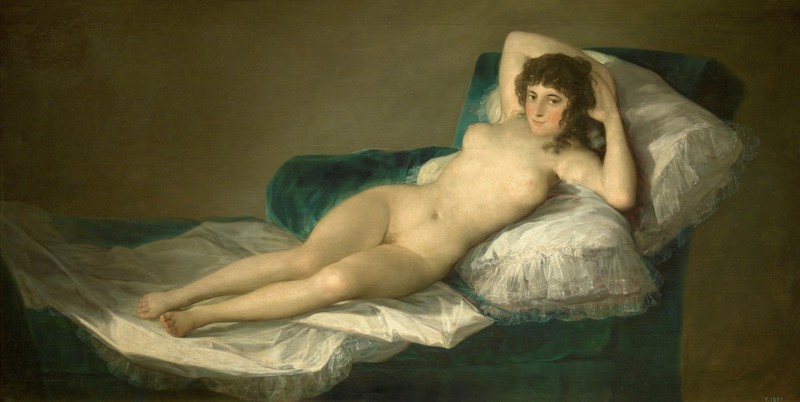Our top 5 of Spanish Art masterpieces that you’ll find in the most important museums in Madrid
The city of Madrid boasts some of the most important museums in Europe: the Prado Museum, the Reina Sofía Museum, and the Thyssen-Bornemisza Museum. In fact, these three meccas of art are connected by a promenade called the Art Walk (Paseo del Arte in Spanish). In just over one mile, you can take a trip from the classical to the avantgarde to meet all the big names. El Bosco, Caravaggio, Velázquez, Van Gogh, Picasso, and many others are waiting to be discovered. In this week’s post, The Touring Pandas have made a selection of our top 5 favorite masterpieces of Spanish Art that you can contemplate in the museums in Madrid.
1. Prado Museum: the start line for museums in Madrid
The Prado Museum is the most important museum in Madrid, and it’s also the most visited in Spain. Furthermore, the importance of the Prado collection is so important that it is counted among the most important museums in Europe and in the world. The Prado Museum is famous for its works of European masters from the 16th to the 19th centuries like El Bosco, Rubens or Tiziano, with the largest collections of these artists worldwide. But the highlight of this art temple are the collections of Spanish masters. The most acclaimed works by Velázquez, Goya and El Greco are guarded by the walls of this museum that receives over 3 million visitors yearly. Two of our top 5 masterpieces of the museums in Madrid belong to the Prado Museum. Keep reading to discover them!
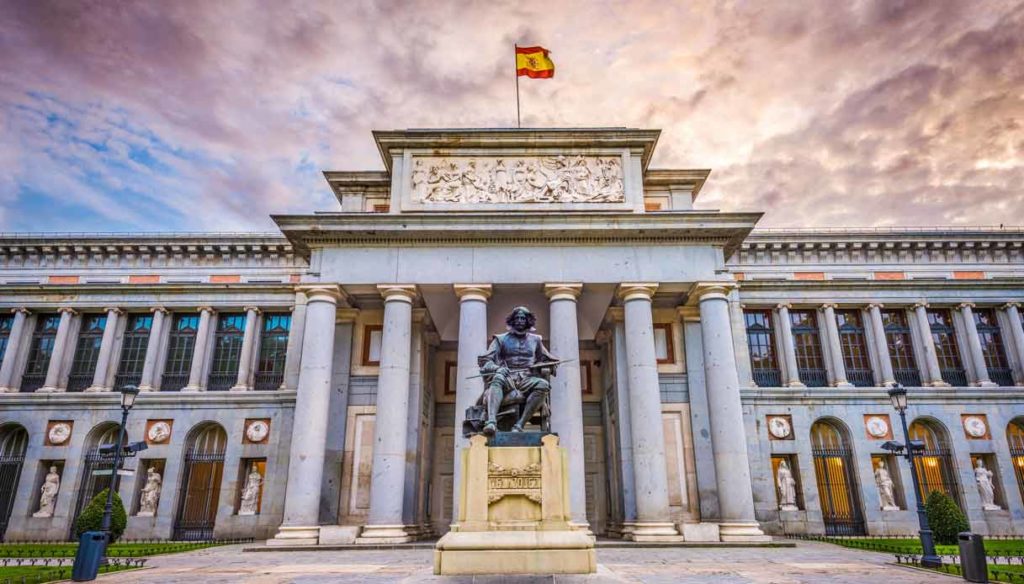
Las Meninas, Velázquez, 1656
Las Meninas, by Diego Velázquez, is the Prado equivalent of La Gioconda in the Louvre. No matter when you visit the museum, there will always be a crowd of people elbowing each other to see the most famous piece of Spanish Art. But, why is it so important? What makes Velázquez’s work so original is that it breaks with the tradition of the royal portraits. Usually portraits are static scenes, where all members of the monarchy are all prepared and striking a pose. But this one captures a backstage scene during the preparation for the actual portrait, and it’s dynamic. The main character, infanta Margarita, is being dressed up with the help of her meninas. The dwarf woman and the dog also contribute to the feeling that this scene should never have been the object of a royal portrait. In the background, there is a mirror with the parents of Margarita, Felipe IV and Mariana of Austria, who witness the scene from the distance. And another breaking element of this portrait is that it actually contains a self-portrait of Velázquez -the man with the bursh and the red cross on his chest- who painted himself as the creator of this masterpiece.
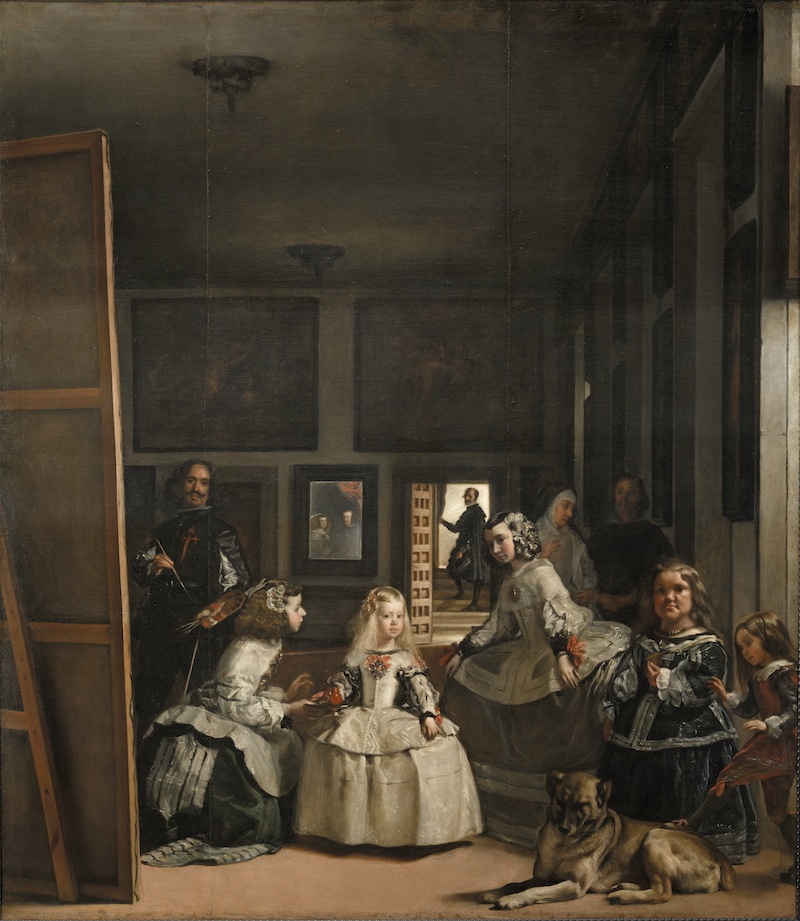
Saturn Devouring His Son, Goya, 1820-1823
The Prado Museum hosts the largest Goya collection in the world including his most acclaimed paintings like La maja desnuda, at the header of this post. One of the most remarkable series by Goya is kown as the Black Paintings, a group of 14 works displayed together in the same room. Goya produced these paintings during the last years of his life, and they show his fear of insanity, as well as a bleak vision of humanity. The Black Paintings are somehow disturbing and even scary. They are very distinct from the rest of Goya’s work, and they anticipated the avantgardes of the late 19th and early 20th centuries. The most representative work of the Black Paintings is Saturn Devoruing His Son. It relates to the Greek myth of Chronos (Saturn was his Roman name). Chronos, the god of time, was afraid that one of his children would overthrow him and take his throne. So he would eat each of his sons at the time of their birth. This is our second choice in this top 5 of masterpieces in the museums in Madrid.
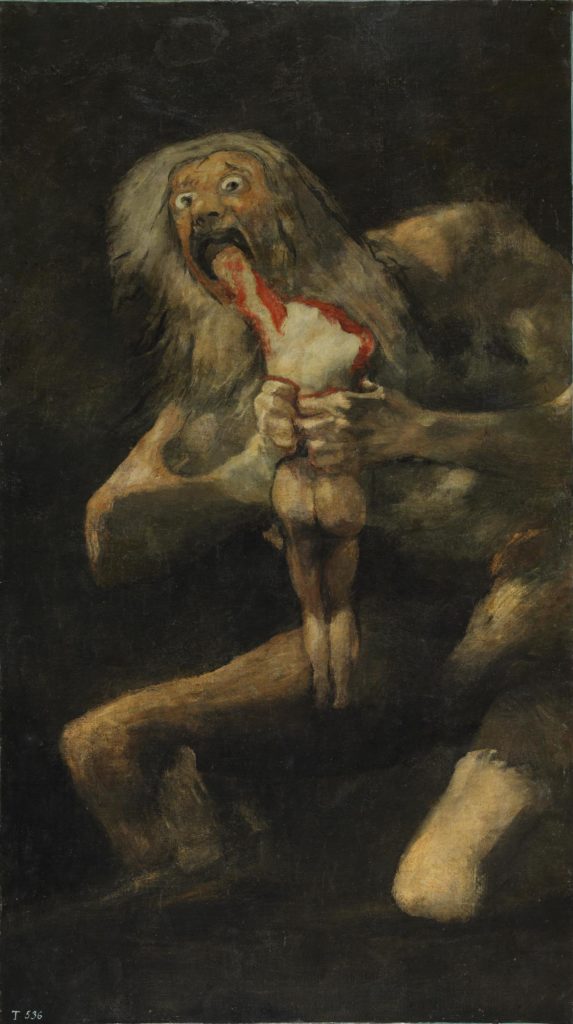
2. Reina Sofía Museum: a place for avantgarde and contemporary art
The Reina Sofía Museum is the second of the most important museums in Madrid. The collection is well kept inside the building of the former General Hospital of Madrid, by architect Francesco Sabatini. The museum was inaugurated in 1992, and it hosts an impressive collection of 20th century and contemporary art. The greatest figures of Spanish modern art, like Picasso, Dalí and Miró, are some of the highlights at the Reina Sofía Museum. We have selected two items from its collection for our top 5 of masterpieces of Spanish Art.
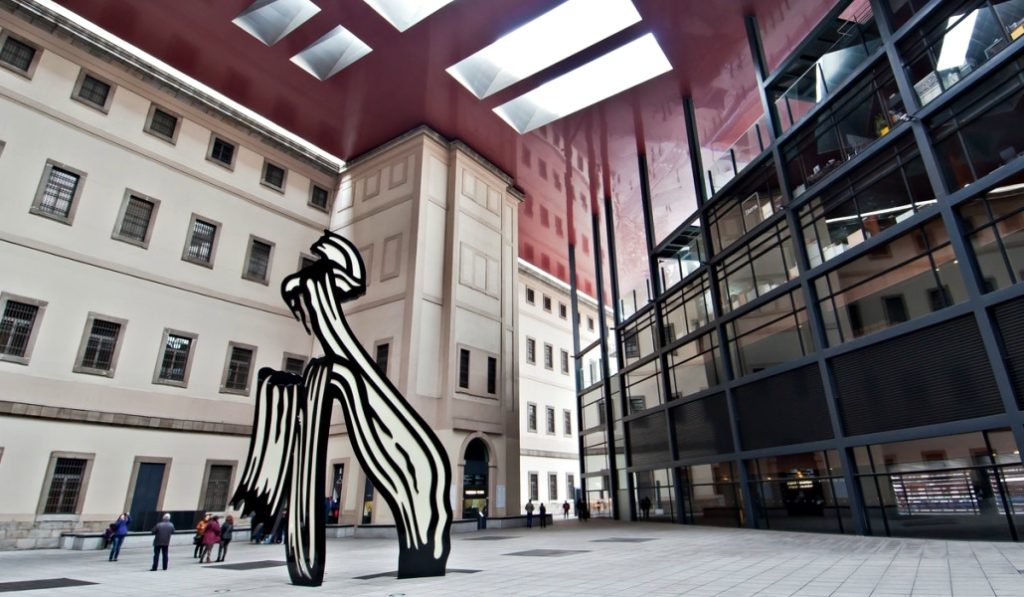
Guernica, Picasso, 1937
Pablo Picasso is probably the most acclaimed Spanish artist of modern times, and Guernica is his most famous work. Contemplating the Guernica is by itself enough reason to visit this museum. In order to understand this masterpiece we need to travel back in time to the Spanish Civil War. Spain went into a fratricidal war in 1936, just three years before World War II. In those days, the German and Italian dictators, Hitler and Mussolini, were growing their armies and willing to test new war methods for the years to come. Franco, the Spanish dictator, allowed them to borrow some cities controlled by the Republicans as a war laboratory. Thus, the German aviation launched a raid on the city of Guernica on April 26, 1937, killing over 1.000 civilians. Shortly after this massacre, Picasso painted the Guernica for the Spanish pavilion at the 1937 Universal Exhibition in Paris, to tell the world about such a dreadful episode. During the Spanish dictatorship, Picasso agreed to keep the painting safe at the MoMA in New York, with the promise that it would go back to Spain once democracy would be reestablished. After Franco’s death and the transition to democracy in 1978, the Guernica returned to Spain in 1981, 42 years after the end of the Civil War.
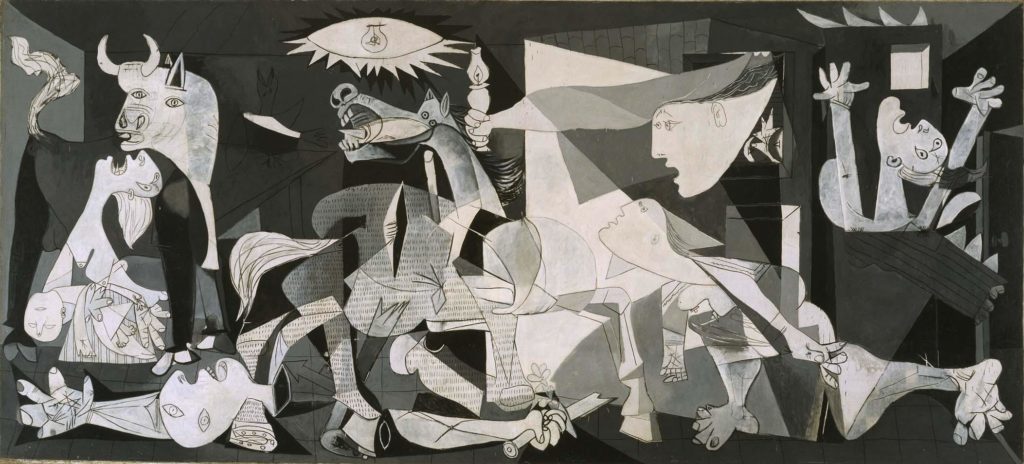
Un mundo, Ángeles Santos, 1929
The second work at the Reina Sofía Museum that makes it to our top 5 is Un mundo (A world) by Ángeles Santos. Although this may be the first time you hear this name, Santos caused a great impression among Spanish intellectuals when she presented her work. With barely seventeen years of age and just a couple of painting lessons on her shoulders, Santos managed to create a masterpiece in line with the latest trends of the European avantgardes. The work presents a cubic world surrounded by female creatures that borrow fire from the sun to bring light to it. This beautiful creation can be inserted in the literary and artistic movement of magic surrealism. Sadly, the reason why you probably haven’t heard this name before is that she was a woman, and only a few women artists have been included in the artistic canons of their times. However, we absolutely love this futuristic masterpiece of Spanish Art, which definitely deserves to be part of our top 5 for the museums in Madrid.
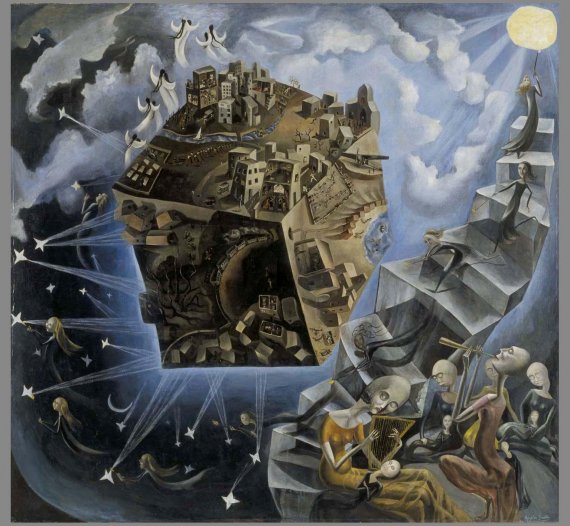
3. Thyssen-Bornemisza Museum: a collection to enjoy and learn about art history
The Thyssen-Bornemisza is the last of the three museums in Madrid that you can’t miss. Once a private collection owned by the Thyssen-Bornemisza family, the Spanish Government bought most of it in 1993 and made it a public museum. Unlike Prado and Reina Sofía, this museum doesn’t have a focus on a specific period. Instead, it is a wonderful journey through art from the 14th to the 21st centuries. The chronological display of the collection makes it the perfect place to understand the evolution of artistic movements from the early ages until today. Van Eick, Rubens, Rembrandt, Monet, Van Gogh, Picasso or Dalí are some of the names you’ll find walking through the pale pink corridors of the Thyssen-Bornemisza Museum.
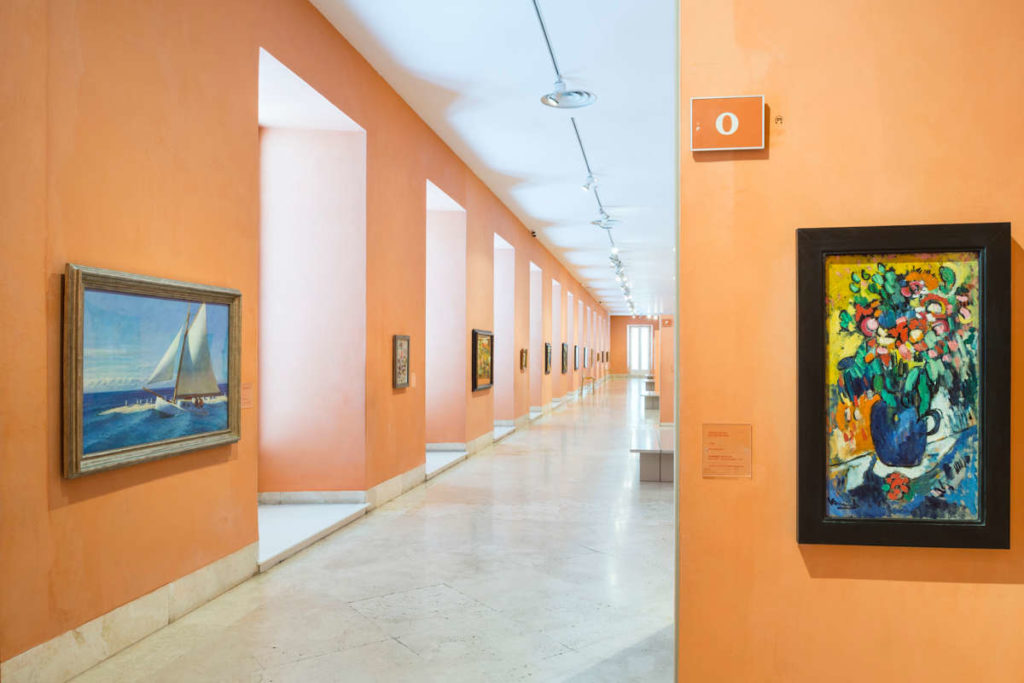
Sueño causado por el vuelo de una abeja alrededor de una granada un segundo antes de despertar, Dalí, 1944
Dream Caused by the Flight of a Bee Around a Pomegranate a Second Before Awakening is the original name of the last item in our top 5. Such an original and twisted name couldn’t be by no other than Salvador Dalí, the genius of surrealism. Dalí’s surrealism recreated the artist’s oeniric world, that is to say, his dreams. And no other work explains it better than this beautiful painting. Gala, Dalí’s muse, is the protagonist: she’s having a quiet sleep somewhere near the sea. At the forefront, there is a pomegranate with a bee flying around it, attracted by this sweet fruit. The buzz of the bee triggers Gala’s dream. In the background, the same pomegranate, but in her dream, explodes. A big fish comes out of it. At its turn, two angry tigers jump from the mouth of the fish, towards the woman. But a flying bayonette (the bee in the real world) pinches Gala in the arm, causing her to wake up.
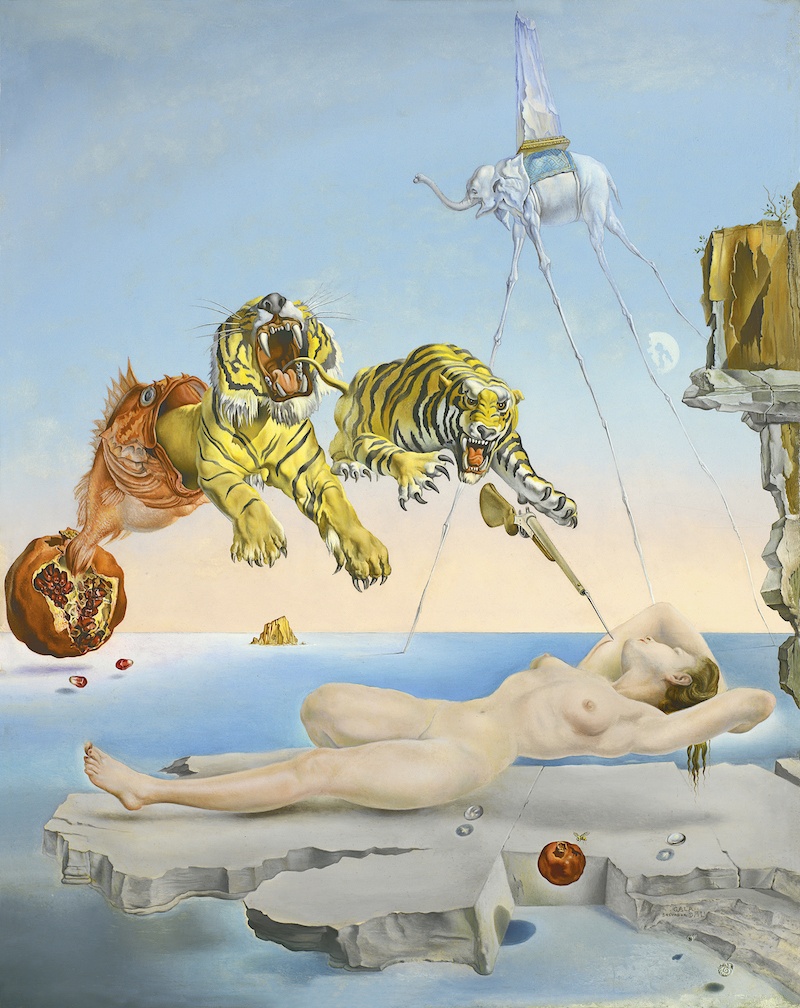
©Salvador Dalí, Fundación Gala-Salvador Dalí / VEGAP
Which of the masterpieces in our top 5 did you know already? Do you agree with our favourites? Which one do you like most? Leave us a comment and let us know your opinion. You can also share any other paintings you love!
If you liked our post about museums in Madrid, recommend it to your friends and learn more tips in our Panda Blog! Remember you can also take our tours to discover the best attractions in Madrid and Barcelona from a local perspective. If you’re an art lover, take the Prado Museum & Art Walk Tour, and discover the art and museums in Madrid with one of our expert guides. Use our Panda coupon in your language to get a 10% discount!
Coupons: CHINA10 – JAPAN10 – KOREA10 – ENGLISH10
You can also follow us on Facebook!


